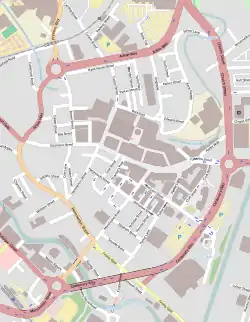 | |
 Burnley Mechanics Location within Burnley town centre | |
| Address | Manchester Road Burnley England |
|---|---|
| Coordinates | 53°47′16″N 2°14′40″W / 53.7878°N 2.2445°W |
| Type | Theatre |
| Construction | |
| Opened | 1855 |
| Architect | James Green (1854–55) William Waddington (1888) |
| Website | |
| www | |
Listed Building – Grade II* | |
| Designated | 19 November 1997 |
| Reference no. | 1244905 |
The Burnley Mechanics is a theatre and former Mechanics' Institute in the market town of Burnley, Lancashire, England. It was built 1854–55 and converted to a theatre in 1979. Historic England has designated the theatre a Grade II* listed building.
History
The Mechanics' Institute was built 1854–55 to a design by Todmorden architect James Green. Sir Charles Towneley opened the institute in 1855.[1] It was a club for "reading and discussion by an 'earnest few'".[2] As the town grew, the institute increasingly became a social and cultural community centre.[1] Architect William Waddington enlarged the building in 1888.[3] Burnley Borough Council bought the building in 1959 and leased it to companies for a variety of leisure purposes.[1][4] In 1979, the interior was reconstructed as a theatre.[3][4]
Burnley Mechanics was designated a Grade II* listed building by Historic England on 29 September 1977.[3] The Grade II* designation—the second highest of the three grades—is for "particularly important buildings of more than special interest".[5] It is described by Hartwell and Pevsner as "one of Burnley's best buildings".[3] John Champness calls its façade "certainly the finest Classical façade in Burnley and among the very best of its date in the country".[6]
Architecture
Burnley Mechanics is built in the Palazzo style in sandstone ashlar.[3] Green's original construction is on a rectangular plan with five bays at the front; it is on two storeys.[4] The ground floor has Venetian-style windows with round, rusticated arches.[4] Waddington's extension at the rear of the building is on a slightly lower level.[4] Its design matches that of the rest of the building, but the newer windows have architraves with pilasters.[3]
On the second floor, there are central windows flanked by Corinthian columns and pilasters.[4] The entrances to the building have coupled Corinthian columns.[4]
See also
References
- Footnotes
- 1 2 3 "Burnley Mechanics — Outline", www.burnley.gov.uk, Burnley Borough Council, archived from the original on 27 September 2011, retrieved 13 June 2011
- ↑ Tylecote, pp. 112–113
- 1 2 3 4 5 6 Historic England, "Burnley Mechanics (1244905)", National Heritage List for England, retrieved 13 June 2011
- 1 2 3 4 5 6 7 Hartwell & Pevsner, pp. 180–181
- ↑ "Listed Buildings", National Heritage List for England, English Heritage, archived from the original on 22 December 2012, retrieved 13 June 2011
- ↑ Champness, p. 134
- Bibliography
- Champness, John (1989), Lancashire's Architectural Heritage: An Anthology of Fine Buildings, Lancashire County Planning Dept., ISBN 0-902228-71-4
- Hartwell, Clare; Pevsner, Nikolaus (2009) [1969], Lancashire: North, New Haven and London: Yale University Press, ISBN 0-300-12667-0
- Tylecote, Mabel Phythian (1957), The Mechanics' Institutes of Lancashire & Yorkshire Before 1851, Manchester University Press, OCLC 458433074
